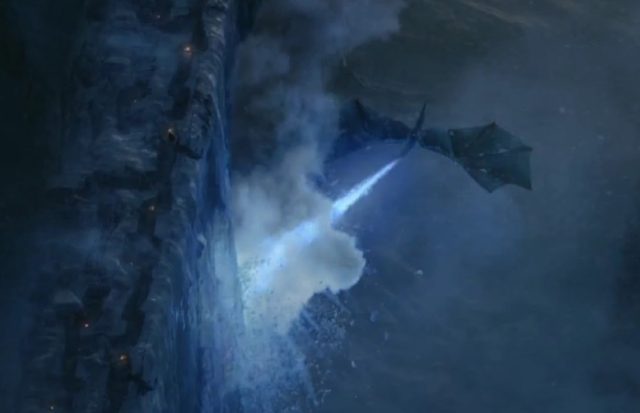Warning: This story contains some mild spoilers from the first seven seasons of Game of Thrones.
The world of Game of Thrones may be fictional, but that doesn't stop its fans from heatedly arguing about all the possible underlying science, because nerd-gassing about one's favorite science fiction is a time-honored tradition. Just how hot is dragon's breath? Is there a real-world equivalent of wildfire? What's the best and worst way to die? And how fast would Gendry have to run back to the wall to send a raven to King's Landing requesting help?
These and other scintillating topics are discussed in a forthcoming book by physicist (and uber-fan) Rebecca Thompson, Fire, Ice, and Physics: The Science of Game of Thrones. The book comes out in October from MIT Press, but as we gear up for the premiere of the final season Sunday night, Thompson graciously gave us a sneak preview into some of the burning science questions she investigated.
Hot fire, hot steel, and hot locks
After completing her PhD, Thompson spent several years doing physics outreach for the American Physical Society, and she authors the society's popular Spectra educational comic book series. (Attendees of San Diego Comic-Con have likely seen her in costume as Spectra on the exhibit floor.) This is her first popular science book, inspired by a talk she gave to physics teachers a few years ago on the physics of dragon fire and ice walls in Game of Thrones. Scouring the many fan sites on which such things are debated at length, she found far more interesting science questions than what could fit into a single talk—it turned into a book's worth of science, in fact.
Fire, Ice, and Physics covers everything from the physics of dragon fire and Valyrian steel, to the best and worst ways to die. Thompson even ponders why Jon Snow never wears a hat in freezing conditions beyond the wall—the obvious answer is that it would mess up his hair, and the author admits to being a fan of said hair. "But wearing a hat is more important than just having thick luscious hair," she said. That's because the head doesn't have much fat to insulate the body against the cold. Also, a hat would keep warm air trapped close to the head, whereas the wind would blow through Jon's unruly locks and dissipate said heat. Still, it's not any worse than not wearing gloves, per Thompson; it's a myth that the body loses most of its heat through the head.

Valyrian steel may be fictional, but there is a real-life counterpart: Damascus steel, known for its high carbon content, which made it brittle and therefore difficult to work with. The secret of how it was made has been lost to history, but a few years ago German scientists x-rayed a sample from a Damascus steel blade and found carbon nanotubes at the sharp edge. They likely formed as a natural result of the smelting process, which strengthened the steel. "When the swords were made, they were often quenched in the urine of red-headed boys," said Thompson. "The acid in the urine etched off all the other material and exposed the carbon nanotubes.
While fire-breathing dragons are entirely fictional, it's still possible to analyze its properties from a scientific perspective. Dragon fire is white-hot, certainly hot enough to melt iron and steel to forge the Iron Throne. It would also be able to melt granite, which is why Harrenhal has "that melted candle look," according to Thompson. The bigger the dragon, the hotter the flame it produces. Drogon, the biggest of Daenerys' three dragons, would spew fire more than capable of melting the Red Keep at King's Landing.
And what about poor Viserion, killed by the Night King and revived as an undead Ice Dragon? He breathes blue fire, and fans have hotly debated whether it burns hot or cold. Per Thompson, a cold blue fire might cause some thermal cracking in the Wall, but probably not enough to take it down entirely. For that you would need hot blue fire—and even then, it would take some time to bore through a 300-foot-wide wall. A simple flyby, as depicted in the Season 7 finale, wouldn't be sufficient (although the Night King keeps Viserion hovering in one spot of the wall for a bit). "The majority of the energy to melt ice is to break the [chemical] bonds, not to raise the temperature," said Thompson.
Wildfire is a chemical weapon that plays a major role on the series. It's not water soluble, which means you can't wash it off and it floats on the surface water. It's sticky, and it burns green. The closest real-world equivalent would be napalm, which was sticky, burns on water, and burns hot enough to melt steel and stone, according to Thompson. Another real-world contender is the "Greek fire" used by the Byzantine Empire. It was fairly stable, could burn on water, and could only be extinguished with vinegar or sand. It likely contained pine tar, sulphur, and either saltpeter or quick lime, among other ingredients. It had all the elements of wildfire except one: wildfire burns green. "The one piece that is hard to reproduce is the green fire, because for that you need certain elements, like copper," she said.

Death decoded
Given the high body count on Game of Thrones, Thompson naturally had to include a chapter on the science of the many different ways to die on the show. For instance, Ned Stark may have experienced a most unjust death at the order of King Joffrey way back in season 1, but beheading is actually one of the more merciful deaths. That said, Ned may well have remained conscious for a good ten seconds after losing his head, based on a study in the Netherlands. The scientist implanted electrodes in the heads of rats and beheaded them using tiny guillotines, and measured how long brain activity continued to register afterward. Then they extrapolated that to humans to arrive at the ten second estimate.
The death of Dany's weaselly brother, Viserys, in season 1 would be an even faster way to die. Recall that Khal Drogo melted down some golden medallions and poured the molten gold over the aspiring king's head. Would Viserys have died of shock, or suffocation? Neither, it seems; he would have died from a boiling brain. Thompson researched the thermal conductivity of bone and found it conducts heat quite well. Molten gold has a temperature of around 1947 degrees F. "If you assume the brain is mostly water (73 percent), his brain would boil extremely quickly," she said—in about 3.5 seconds. "He would probably never even feel the heat. If you consider what would be the most merciful death on the show, it would absolutely be the Golden Crown."
By far the most agonizing death was that suffered by poor Shireen Baratheon in season 5—a death so horrible that Thompson had a difficult time even writing about it. The most merciful way to burn someone at the stake is to pile up green wood in such a way as to enclose the victim, so that they die from smoke inhalation fairly quickly. In the case of Shireen, the wood was stacked on a pallet at her feet, burning her from the bottom up and ensuring she was conscious for most of her agonizing death. It could have taken as long as 30 minutes for her to die. So Melisandre lied when she told a frightened Shireen, "It will all be over soon."

Another means of slow, painful death would be the fictional Manticore poison on the tip of Oberyn'Read More – Source
[contf] [contfnew] 
Ars Technica
[contfnewc] [contfnewc]







